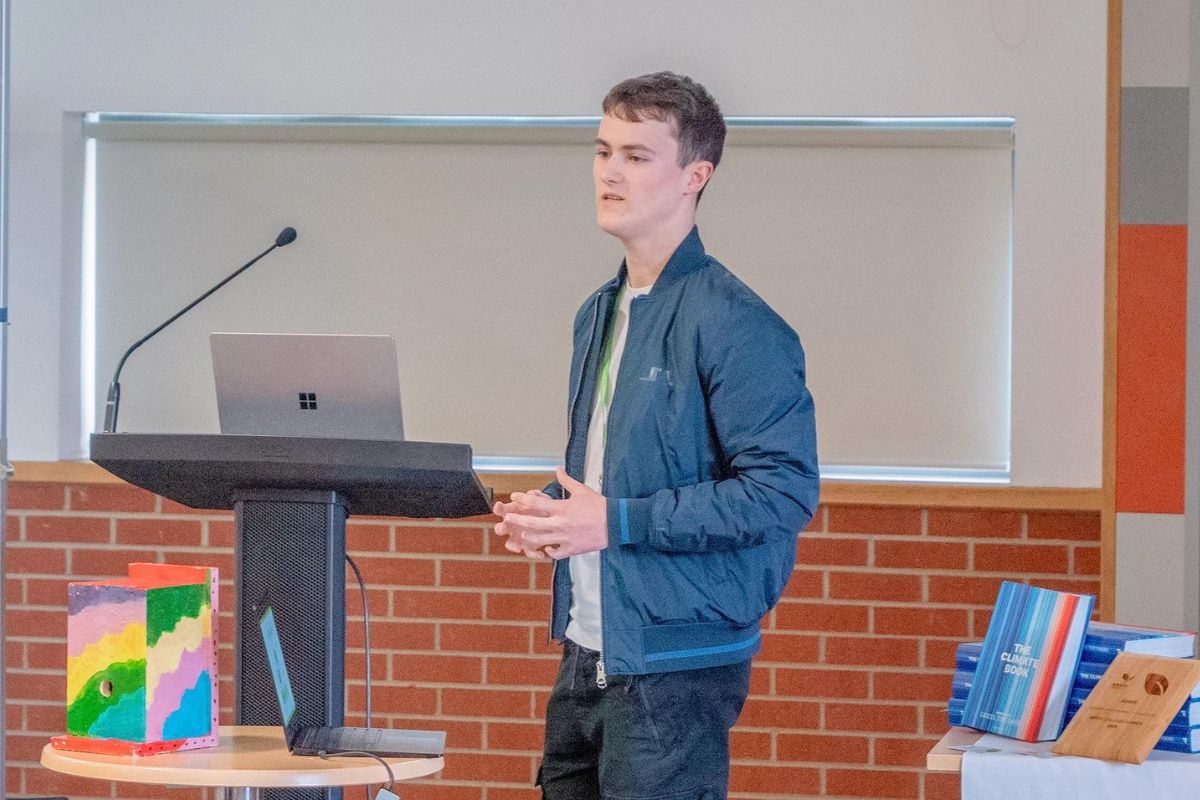COVID workforce fund extended until spring half-term 2022

The COVID-19 workforce fund has been reintroduced to provide financial support to settings with the greatest staffing and funding challenges.
The fund has been extended to help eligible settings cover the cost of workforce absences experienced from 22 November 2021 until spring half-term.
Schools and Colleges can backdate claims to 22 November 2021 where they met the eligibility criteria.
The guidance sets out details of the fund, including the eligibility criteria and claims system.
Coronavirus (COVID-19) workforce fund for colleges
16th Dec 2021: Funding to support colleges and special post-16 institutions with the costs of staff absences from 22 November until spring half-term 2022.
Applies to England
Documents
COVID-19 workforce fund to support colleges and special post-16 institutions
HTML
Details
This guidance sets out the eligibility criteria and claims process for the COVID-19 workforce fund for colleges. It applies to:
- general FE colleges
- sixth form colleges
- special post-16 institutions
Published 15 December 2020
Last updated 16 December 2021 – hide all updates
- 16 December 2021 Updated the guidance to reflect that the COVID-19 workforce fund has been extended.
- 30 November 2021 Updated guidance following the reintroduction of the COVID-19 workforce fund for colleges.
- 15 December 2020 First published.
Coronavirus (COVID-19) workforce fund for schools
Funding to support schools facing significant staff absences and financial pressures with the costs of staff cover for the period from 22 November 2021 to 18 February 2022.
Applies to England
Documents
Coronavirus (COVID-19) workforce fund to support schools with costs of staff absences from 22 November 2021 to 18 February 2022
HTML
Details
Guidance setting out the eligibility criteria and claims process for the COVID-19 workforce fund for schools. It applies to:
- primary, secondary and all through maintained schools, academies and free schools
- 16 to 19 academies and maintained schools
- maintained special schools, and special academies and free schools
- non-maintained special schools
- pupil referral units
- alternative provision academies and free schools
- maintained and academy hospital schools
Registered independent special schools and independent schools delivering alternative provision are also eligible to claim for staff they employ to support pupils whose placements are funded from local authorities’ high needs budgets.Published 15 December 2020
Last updated 16 December 2021 – hide all updates
- 16 December 2021 The COVID-19 workforce fund has been extended until 18 February 2022.
- 30 November 2021 Updated guidance following the re-introduction of the coronavirus (COVID-19) workforce fund.
- 15 December 2020 First published.
Coronavirus (COVID-19) workforce fund for schools and colleges until 2022
30th Nov 2021: The COVID-19 workforce fund has been re-introduced to provide financial support to settings with the greatest staffing and funding challenges.
The fund helps eligible schools and colleges cover the cost of workforce absences experienced from 22 November 2021 until the end of the term.

Geoff Barton, General Secretary of the Association of School and College Leaders, said:
“Many schools and colleges are footing huge extra costs for supply cover for staff who are absent because of Covid, and this situation is likely to worsen as a result of the new Omicron variant of the virus. We have called for the reopening of the Covid workforce fund to provide financial assistance to schools and colleges with these costs and we are pleased the government has listened.
“However, we are disappointed that the window for claims is so short covering only the period from 22 November until the end of the year. Schools and colleges have been experiencing these shortages for many weeks now and they are likely to continue for some time to come. And we are also disappointed that access to this funding is dependent on a similar maze of eligibility criteria as that applied last time it was available for a limited period last year.
“The workforce fund should be available for as long as needed rather than for short windows of time and this support should come without so many conditions attached.”

Paul Whiteman, general secretary of school leaders’ union NAHT, said:
“The reintroduction of the Covid workforce fund is a welcome acknowledgement of the difficulties schools are facing at the moment with very high levels of staff absence.
We would like the financial support for supply costs to be extended in order to reach every school that needs it, but this is certainly a welcome step in the right direction.
“An NAHT poll taken in July this year showed that the cost of supply cover for sick and isolating staff put huge pressure on school budgets, with average estimated additional staff costs of £12,000 per school since the start of the pandemic.”
COVID-19 workforce fund to support colleges and special post-16 institutions
The COVID-19 workforce fund has been reintroduced to provide financial support to settings with the greatest staffing and funding challenges. The fund helps eligible settings cover the cost of workforce absences experienced from 22 November 2021 until 31 December 2021 inclusive.
Colleges can backdate claims to 22 November 2021 where they met the eligibility criteria.
The guidance sets out details of the fund, including the eligibility criteria and claims system.
Types of settings eligible for this funding
Funding is available for:
- general FE colleges (including specialist designated institutions)
- sixth form colleges
- special post-16 institutions
Throughout the guidance when referring to ‘colleges’ we are referring to these settings.
Costs covered by the fund
Colleges are already taking steps to manage absences using their existing staff and resources. As set out in the conditions for accessing this funding, colleges should only apply for this fund once they have used other options as far as possible.
To cover teacher absences, colleges can claim for the cost of:
- employing, through agencies or directly contracting, supply teachers, or supply support staff where that role is to cover teacher absences
- increasing hours of part-time teaching staff where the additional hours are being used to cover teacher absences or increasing hours of part-time education support staff where that role is to cover teacher absences, colleges should ensure staff are happy to temporarily increase their hours and consider their staff workload and wellbeing
- making necessary amendments to support staff terms and conditions to enable them to take on additional responsibilities – the principal or chief executive should determine this in discussions with the employee
To cover support staff absences, colleges can claim for the cost of:
- employing supply education and non-education support staff either through agencies or directly contracting
- increasing the hours of part-time education and non-education support staff, colleges should make sure staff are happy to temporarily increase their hours and consider their workload and wellbeing
Costs not covered by the fund
Colleges cannot claim for:
- training or other incidental staff-related costs
- increasing pro-rata pay, unless there is a commensurate increase in responsibilities associated with undertaking the work
- cover for absence where the teaching or training delivery is undertaken on a fully commercial basis
- capital costs to support staff delivering education remotely
Staff included in the funding
Colleges can only claim for covering the absences of:
- permanent staff who are on their payroll
- staff employed on a long-term contract (for example maternity cover, long-term sick cover)
They cannot claim for temporary staff.
When referring to support staff absences we expect this to include both educational and non-educational support staff.
Educational support staff
This may include specialist support staff where they are necessary to avoid full or partial closure or fulfilling a legal duty.
Non-education support staff
This may include staff who are necessary to avoid full or partial closure or fulfilling a legal duty, for example:
- cleaning
- catering
- transport
- IT
- estates
This may also include therapists and other support staff in health-related roles in special post-16 institutions or special provision units within mainstream colleges.
Conditions for accessing this funding
The criteria set out for this fund are designed to target those colleges experiencing high absence rates and significant funding pressures. It covers the costs of staff absence in colleges over the thresholds specified.
Essential criteria
Where relevant, colleges will be asked to self-certify that they meet these criteria on the claims form.
There are 2 main criteria or thresholds that colleges must meet to be eligible:
- a financial threshold
- a workforce absence threshold
In addition to this, colleges must be able to show that they:
- were open for on-site delivery on the days in question
- can certify that staffing absences claimed for through this fund are necessary in avoiding partial or full closure, or to maintain onsite delivery – this includes assessing their need for additional staff funding, for example, whether staff cover is needed if a teacher is providing remote education while isolating
- can evidence claims as set out in the section on evidence for claims and the assurance process
- are not claiming for costs from an existing insurance policy, for example, a supply teacher or staff absence insurance policy
- have tried alternative mitigations first before claiming for the funding – colleges should only apply for this fund once these options have been used
Example
If a college meets the absence threshold but there remains scope to manage their staff absences using existing staff and resources, these should be used in the first instance.
Financial threshold
Sixth form and general FE colleges will be eligible if the data submitted for the November financial return demonstrates an end of month cash position of 45 days or less for the corporation at any point over the period November 2021 to March 2022.
Special post-16 institutions will be eligible for this additional funding if their reserves at the end of March 2021 are no more than 4% of their annual income. Through the assurance process, funding can be clawed back where this criterion is not met at the year-end.
Workforce absence threshold
Absence threshold for sixth form and general FE colleges
To meet the criteria for the fund sixth form and general FE colleges must be experiencing either:
- a teacher absence rate at or above 20% on a given day
- a teacher absence rate of 10% or above where that has been experienced for 15 or more consecutive days (not including weekends)
Colleges are only able to claim for absence costs above the threshold.
By ‘day’ we mean a weekday on which the college is fully open for onsite delivery, in line with the FE operational guidance.
Colleges must exceed either of the absence thresholds for their setting to be eligible. Once they exceed either threshold, they are eligible to claim for costs incurred covering absences above this.
Where absences claimed under the short-term threshold become long-term, colleges must no longer count this towards their short-term absence rate. They must avoid double claiming for the same absences. The expenditure must meet the list of permitted spend set out in this guidance.
Colleges should calculate their teacher absence rate at a whole corporation level rather than the individual teacher level. For example, they may have a sustained absence rate of 15% for 4 weeks, but with different staff members absent throughout that period.
Where a college corporation delivers its provision on multiple campus sites, where possible, corporations are expected to consider options to use existing capacity across different sites to mitigate staff absence before considering additional staffing spend. Where the movement of staff between individual sites is not viable, the absence threshold can (as an alternative) be applied at a campus level. However, this should only apply where it can be demonstrated that respective sites are not within a reasonable travel time of each other, for example, more than an hour apart by car.
Example 1
A college experiences an absence rate of 15% for 20 days, which then reduces to 8%.
The college could claim for up to 5% for 6 days (for days 15 to 20).
Example 2
A college experiences an absence rate of 8% for 20 days, which then spikes to 28% for 5 days.
The college could claim for up to 8% for 5 days (for the period during which they are at 28%).
Example 3
A college experiences an absence rate of 12% for 20 days but then sees an increase in cases and for 5 days has an absence rate of 23%.
The college could claim for up to 2% for 6 days (for days 15 to 20), plus up to 13% for 5 days (for days 21 to 25).
Example 4
A college experiences an absence rate of 23% for 5 days but then sees absence rates drop to 18% for another 15 days.
The college could claim for up to 3% for the first 5 days (for the period when they are experiencing 23%), and then up to 8% for the final 6 days (for days 15 to 20).
Example 5
A college experiences an absence rate of 23% for 5 days but then sees absence rates drop to 18% for another 9 days, and then to below 10% after that.
They could only claim for up to 3% for the first 5 days.
Claims for support staff absences can be made on an exceptional only basis, where colleges certify that providing cover for that role is necessary for maintaining onsite delivery or meeting legal duties.
Colleges must certify that they have tried alternative mitigations to manage these absences.
Absence threshold for special post-16 institutions
When claiming for teacher absence costs, special post-16 institutions must be experiencing either:
- a total teacher and leader absence rate at or above 15% on a given day
- a total teacher and leader absence rate of 10% or above where that has been experienced for 15 or more consecutive days (not including weekends)
In addition, when claiming for education and non-education support staff costs, special post-16 institutions must be experiencing either:
- a total support staff absence rate (teaching assistants and other staff) at or above 15% on a given day
- a lower total support staff absence rate (teaching assistants and other staff) of 10% or above where that has been experienced for 15 or more consecutive days (not including weekends)
Once these thresholds are reached, claims can be made for roles which are necessary for maintaining critical provision for students in special post-16 institutions, where the special post-16 institution certifies that these roles cannot otherwise be managed using existing staff and resources.
Claims can also be made on an exceptional basis where cover for support staff (below these thresholds) is necessary for avoiding closure or fulfilling legal duties. Special post-16 institutions must certify that they have tried alternative mitigations to manage these absences.
How colleges can access funding
We are asking colleges to make the necessary payments from their existing budgets and record these in line with local finance policies.
Colleges will be able to make claims for costs eligible for reimbursement through this fund in spring 2022. We will publish detailed guidance about the claims process then.
We will only reimburse costs relating to the list of permitted spend covered in this guidance and where the college is eligible and meets the conditions outlined in this guidance. We expect colleges to be financially prudent when sourcing cover.
Evidence for claims and the assurance process
Colleges will need to provide assurance that costs are legitimate additional workforce costs incurred due to staff absence by taking necessary measures.
Before submitting claims, colleges should:
- make sure they have considered the criteria and can certify that they meet those criteria when claiming
- consider whether they meet the financial threshold and workforce absence threshold
- ensure that they retain evidence to demonstrate that the absence threshold has been met for each day claimed
- keep records of all expenditure relating to staff absence – as is usual with all spend, these records will be necessary for local audit arrangements
- make sure they keep records to evidence the eligibility of support staff
- confirm that the chief executive, principal, finance director or business manager who submits the claim has given due consideration to their financial duties when doing so and certifies that the claim is fraud and error-free
- be able to identify this income, and the related expenditure, and confirm it was appropriately used, when reporting their accounts
To reduce the burden of duplicating this data return, colleges can choose to provide consent on their claims form which allows us to access any data relevant to their application that is already provided via the educational settings status form. If consent is given, this data will be used as the initial basis upon which claims will be checked, though we reserve the right for post assurance checks to validate these returns.
Colleges can submit one claim overall but will need to itemise each period of absence claimed. We will not be asking for evidence of the individual items to be submitted on a claim. However, colleges should hold a record of what has been covered, in case of individual enquiries.
As usual, we reserve the right to audit the expenditure and claw back money if claims have not been made in accordance with the guidance, to protect public spending. We will be carrying out assurance checks on a sample of the claims.
The college must notify DfE immediately via the ESFA enquiry form where it becomes aware of any instance of error, suspected fraud or financial irregularity in the claim.
Wider funding context
Colleges will continue to receive their core funding allocations. This will happen regardless of any periods of partial or complete closure and will ensure colleges can continue to pay staff and meet other regular financial commitments.
Colleges may also be receiving funding through the 16 to 19 tuition fund to support young people to catch up lost learning. Colleges should continue to use this funding for specific activities to support their students to catch up for lost teaching over the previous months. Colleges must not divert this funding to help meet the costs of staff absence.
High needs funding
Local authorities will also continue to receive their high needs budgets and should continue to pay top-up and other high needs funding to colleges. This will ensure that the employment and payment of staff supporting students with special educational needs and disabilities (SEND) can continue.
The funding set out in this guidance is not intended to cover any additional costs relating to changes in SEND provision organised by local authorities for individual children and young people with education, health and care (EHC) plans.
Coronavirus (COVID-19) workforce fund to support schools with costs of staff absences from 22 November to 31 December 2021
The guidance sets out details of the fund, including the eligibility criteria and claims system.
Schools eligible for this funding
Funding is available for all state-funded mainstream and special schools, and alternative provision (AP) that provide education to all pupils who are required to be in compulsory education. This includes:
- primary, secondary and all through maintained schools, academies and free schools
- 16 to 19 academies and maintained schools
- maintained special schools, and special academies and free schools
- non-maintained special schools
- pupil referral units
- AP academies and free schools
- maintained and academy hospital schools
Registered independent special schools and independent schools delivering AP are also eligible to claim for the staff they employ to support pupils whose placements are funded from local authorities’ high needs budgets.
Costs covered by the fund
Schools are already taking steps to manage absences using their existing staff and resources. These include:
- altering the way in which they deploy their staff and using existing staff more flexibly
- making the best use of teaching assistants
- hosting initial teacher training (ITT) trainees
- using volunteers
- engaging supply staff using in-year allocated budget
- seeking support from the local authority or trust
As set out in the conditions for accessing this funding, schools should only apply for this fund once they have used other options, as far as possible.
Teacher absences
To cover teacher absences, schools can claim for the following expenditure:
- employing, through agencies or directly contracting, supply teachers, or supply support staff
- increasing hours of part-time teaching staff or increasing hours of part-time education support staff – schools should ensure staff are happy to temporarily increase their hours and consider staff workload and wellbeing
- making necessary amendments to support staff terms and conditions to enable them to take on additional responsibilities – the headteacher and the employer should determine this in discussions with the employee
To cover teacher absences, schools cannot claim for the following expenditure:
- training or other incidental staff-related costs
- increasing pro-rata pay, unless there is a commensurate increase in responsibilities associated with undertaking the work
Support staff absences
To cover support staff absences, schools can claim for the following expenditure:
- employing supply education and non-education support staff through agencies or directly contracting
- increasing hours of part-time education and non-education support staff – schools should ensure staff are happy to temporarily increase their hours and consider staff workload and wellbeing
To cover support staff absences, schools cannot claim for the following expenditure:
- training or other incidental staff-related costs
- increasing pro-rata pay, unless there is a commensurate increase in responsibilities associated with undertaking the work
Costs not covered by the fund
The following expenditure is also not permitted within the scope of this fund:
- enabling schools to maintain their reserves above the 4% of annual limit set out in the financial reserves criteria
- capital costs to support staff delivering education remotely
Considerations for schools
When seeking additional external capacity, schools could consider sourcing staff through:
- temporary direct hire
- their local authority or trust
- recruitment and employment agencies
Schools should exercise financial prudence and seek the best rates they can. Where costs are particularly high relative to the absent rates reported, we may review these claims to judge whether such costs were incurred reasonably.
Where schools are using recruitment and employment agencies, we recommend they use the Department for Education (DfE) and Crown Commercial Service agency supply deal. This:
- offers a list of preferred suppliers that must be transparent about the rates they charge
- allows schools to look for the best rate in their area
- limits temporary to permanent fees for assignments of less than 12 weeks and eliminates these fees entirely for assignments lasting 12 weeks or more
To learn more about the deal, contact the Supply Desk at Crown Commercial Services by emailing [email protected].
Staff included in the funding
Schools can only claim for covering the absences of permanent staff who are on their payroll or those employed on a long-term contract, for example, maternity cover or long-term sick cover. They cannot claim for temporary staff.
When referring to support staff absences, we expect this to include both educational and non-educational support staff.
For educational support staff, we expect this may include teaching assistants or specialist support staff where they are necessary for remaining open to all pupils or fulfilling a legal duty.
For non-education support staff, this may include staff who are necessary in remaining open to all pupils or fulfilling a legal duty, for example:
- cleaning
- catering
- transport
- caretaking
In special schools or AP settings, this may also include therapists and other support staff in health-related roles.
Conditions for accessing this funding
The criteria set out for this fund are designed to target those schools experiencing high absence rates and significant funding pressures. The fund covers the costs of staff absence over the thresholds specified below in these schools.
Prerequisite criteria
Where relevant, schools will be asked to self-certify that they meet these criteria on the claims form.
Schools can only apply in the following circumstances:
- they were open to all pupils (except where pupils are not physically in school, complying with clinical or public health advice) on the days in question
- they have tried alternative options, before claiming for the funding – for example, if a school meets the teacher absence threshold but can still manage this using existing staff and resources (including at trust level), these alternative options should be used rather than claim on the fund
- they can certify that the staffing absences claimed for, are necessary spend to remain open to all pupils – this includes assessing their need for additional staff funding
- they are able to evidence claims as set out in evidence for claims and the assurance process
- costs are not already covered by an existing insurance policy, for example, a supply teacher or staff absence insurance policy
Financial reserves criteria
Before claiming, schools will first need to use any existing financial reserves, as we would typically expect when facing unforeseen costs. For academies, we will consider the financial reserves at trust level (either single academy trust or multi-academy trust, as appropriate).
Schools and academy trusts should consider their level of reserves based on their expected financial position at the end of the current funding year. This ends in March 2022 for maintained schools and August 2022 for trusts.
Schools will be eligible for this additional funding if their reserves at the end of the funding year are down to a level of no more than 4% of their annual income. Trusts will be eligible to claim for any of their academies once their level of reserves is down to 4% of total trust income. Schools and trusts should be aware that through the assurance process funding can be clawed back where this criterion is not met at the year end.
We define schools’ financial reserves as follows:
- for maintained schools – all revenue balances are as defined by consistent financial reporting framework
- for academy trusts – we define revenue reserves as the balance of the General Annual Grant (GAG) restricted income fund plus the balance of unrestricted funds
- for non-maintained special schools, independent special schools and independent schools making AP – we will expect to see the school’s latest financial statements and management accounts, showing performance against budget for its current accounting year, including the period November to December 2021
Workforce absence rate criteria
Schools must reach either of the absence thresholds set out to be eligible. This means either an initial threshold of 20%, or a lower threshold of 10%, if absence levels are long term. Costs can only be claimed for absences above, not at, the threshold. A school experiencing absence at, but never above, the threshold would not be eligible to receive any funding.
Once the long-term threshold is reached, this overrides the higher 20% short-term threshold. In this circumstance, schools can be funded for absences above the long-term threshold, until they are no longer meeting the criteria.
Teacher absence rates are to be calculated at a whole school level rather than at an individual teacher level.
ExampleA school may have a sustained absence rate of 15% for 4 weeks, but with different staff members absent throughout that period.
Schools within a trust can calculate their absence rate at an individual school level rather than a total level across the trust. They will, however, only be eligible for funding once the trust has met the financial reserves criterion.
‘School days’ are days which the school is open for core, statutory provision with pupils in school. We expect this is typically Monday to Friday for mainstream schools, though may also include weekend days for residential special schools. It does not include days where the school is open for other purposes such as building hire, or on INSET days.
Absence rates experienced from the start of November count towards meeting the long-term criteria on any day from 22 November, but claims can only be made for costs incurred since this date.
ExampleIf a school experienced an absence rate of 12% from 2 November until 23 November inclusive, they could claim for up to 2% for 22 and 23 November.
For mainstream schools – teachers
Schools must be experiencing either:
- a total teacher and leader absence rate at or above 20% on a given day
- a lower total support staff absence rate at or above 10% but have been experiencing this for 15 or more consecutive school days
For mainstream schools – education and non-education support staff
Schools can claim for education and non-education support staff absences on an exceptional only basis.
This means only where they certify that providing cover for that role is necessary for remaining open to all pupils or meeting legal duties.
ExampleA teaching assistant is required to fulfil support required by an education, health and care (EHC) plan, where this support cannot otherwise be covered by other staff in the school.
ExampleStaff delivering catering provision, where they are employed directly by the school. Schools must certify that they have tried alternative mitigations to manage these absences.
For special and alternative provision schools, including registered independent special schools and independent schools delivering alternative provision – teachers
Schools must be experiencing either:
- a total teacher and leader absence rate above 15% on a given day
- a lower total teacher and leader absence rate above 10% but have been experiencing this for 15 or more consecutive school days
For special and alternative provision schools, including registered independent special schools and independent schools delivering alternative provision – education and non-education support staff
Schools must be experiencing either:
- a total support staff absence rate (teaching assistants and other support staff) at or above 15% on a given day
- a lower total support staff absence rate at or above 10% but have been experiencing this for 15 or more consecutive school days
Once these thresholds are reached, claims can be made for roles which claimants deem to be necessary for maintaining critical provision for pupils in these schools. They must also certify that they have tried alternative mitigations to manage these absences.
Claims can also be made on an exceptional basis, as per mainstream schools, where cover for support staff (below these thresholds) is necessary for remaining open to all pupils or fulfilling legal duties. They must again certify that they have tried alternative mitigations to manage these absences.
Examples of teacher absence thresholds for mainstream schools
These examples use the teacher absence thresholds for mainstream schools.
Example 1A school experiences 15% teacher absence for 4 school weeks (20 days), which then reduces to 8%. The school could claim for up to 5% for 6 days (for working days 15 to 20).
Example 2A school experiences 8% teacher absence for 4 school weeks (20 days), which then spikes to 28% for a week. The school could claim for up to 8% for 5 days (for working days 21 to 25 when they are at 28%).
Example 3A school experiences 12% teacher absence for 4 school weeks (20 days) but then sees a spike in cases and for one week after that month has an absence rate of 23%. The school could claim for up to 2% for 6 days (for working days 15 to 20), plus up to 13% for 5 days (for working days 21 to 25).
Example 4A school experiences 23% teacher absence for one school week but then sees absence rates drop to 18% for another 3 weeks. The school could claim for up to 3% for the first 5 days (for the week where they are experiencing 23%), and then up to 8% for the final 6 days (for working days 15 to 20).
Example 5A school experiences 23% teacher absence for one school week but then sees absence rates drop to 18% for another 9 days, and then to below 10% after that. The school could only claim for up to 3% for the first 5 days.
How schools can access funding
We are asking schools to make the necessary payments from their existing budgets and record these in line with local finance policies. Schools and academy trusts will be able to make claims for costs eligible for reimbursement through this fund in spring 2022. We will publish detailed guidance about the claims process then.
Schools and trusts should note that we will only reimburse costs:
- relating to the list of costs covered by the fund
- where the school is eligible and meets the conditions for accessing this funding
We expect schools to be financially prudent when sourcing cover.
Evidence for claims and the assurance process
Schools will need to provide assurance that costs are legitimate additional workforce costs incurred due to staff absence. Annex: evidence of meeting criteria outlines the evidence required at the point of claim. Before submitting, schools should:
- consider whether they meet the prerequisite criteria, financial reserves criteria and workforce absence rate criteria
- ensure that they have kept records to evidence the eligibility of support staff claims
- ensure that they have kept records of all expenditure relating to staff absence – these should be available promptly upon request – as is usual with all spend, these records will be necessary for local audit arrangements
- confirm that the headteacher or school business manager who submits the claim has given due consideration to their financial duties when doing so, including signing their name against any claim, to certify the claim is fraud and error free
- be able to identify this income, and the related expenditure, and confirm it was appropriately used, when reporting their accounts
- ensure they have retained evidence to demonstrate that the absence rate criteria has been met for each day claimed
We strongly encourage schools to regularly submit data via the educational setting status form. This will make the claims process less burdensome for schools and enable easier processing.
On the funding claim form, we will ask schools to give consent for us to use data from the educational setting status form to provide assurance on the absence rates submitted with their claim. Where we use this data, we will request that schools make sure it is complete and accurate. Where we are not able to use this data, schools will need to indicate this on the claim form and retain evidence for checking.
Non-maintained special schools, independent special schools and independent schools delivering AP do not use the educational setting status form. They will need to indicate this on the claim form and retain evidence for checking. Data provided in either format will be used as the initial basis upon which claims will be managed, though we reserve the right for post assurance checks to validate these returns
Schools can submit one claim overall but will need to itemise each period of absence claimed. We will not be asking for evidence of the individual items to be submitted on a claim. However, schools should hold a record of what has been covered, in case of individual enquiries.
As usual, we reserve the right to audit the expenditure and claw back money if claims have not been made in accordance with the guidance, in order to protect public spending. We will be carrying out assurance checks on a sample of the claims.
The school must notify DfE immediately through the Education and Skills Funding Agency (ESFA) enquiry form where it becomes aware of any instance of error, suspected fraud or financial irregularity in the claim.
Wider funding context
Schools will continue to receive their core funding allocations for the 2021 to 2022 funding year.
This is April 2021 to March 2022 for maintained schools and September 2021 to August 2022 for academies and non-maintained special schools.
This will either be through the local authority, for maintained schools, or through the general annual grant (GAG) for academies.
This will ensure schools can continue to pay staff and meet other regular financial commitments.
High needs funding
Local authorities will continue to receive their high needs budgets. Local authorities should continue to pay top-up and other high needs funding to schools, colleges and early years settings, for pupils who have special educational needs and disabilities (SEND) and who are in AP. Payments of high needs funding should continue unless there are changes in SEND provision organised by local authorities for individual children and young people in accordance with changes to their education, health and care (EHC) plans.
This will ensure that the employment and payment of staff supporting pupils with SEND and pupils in AP can continue.
Similarly, where schools pay top-up or other funding for AP or SEND services, we expect these payments to continue during temporary staff absences. This is so that teachers and other staff can be paid in accordance with their existing employment contracts. Local authorities and schools should not be expected to pay more high needs top-up funding, or more for SEND and AP services, to cover extra workforce costs incurred by the schools due to staff absences.
Short-term support with costs
We recognise that some schools may be unable to make up-front payments to cover the additional costs because of cash flow issues. In these circumstances, schools should follow the normal process for seeking short-term advances to support their cash flow. They should contact ESFA if they are an academy, or their local authority if they are a maintained school.
Non-maintained special schools with cash flow difficulty should seek advice from ESFA in the first instance.
Annex: evidence of meeting criteria
| Criteria | Evidence (at point of claim) |
|---|---|
| The claim must relate to absences that occur during the period 22 November to 31 December 2021 | Only claims entered for periods within this date range will be accepted |
| Only eligible settings may apply | Institutions that claim must fall under one of the categories listed in schools eligible for this funding |
| Only one claim per school (this includes schools that are part of a multi-academy trust) | Claim form only allows one claim per school (which can be updated if needed until the close of the claim window), with schools itemising each period of absence claimed |
| Only claim for expenditure against the list of permitted spend set out in this guidance | The claim form contents |
| Staff are on a permanent or long-term contract (this can include maternity or long-term sick cover) | Self-certification via the claim form |
| Schools were open to all pupils (except where pupils are not physically in school, complying with clinical or public health advice) on the days in question | Self-certification via the claim form |
| Alternative mitigations explored and exhausted | Self-certification via the claim form |
| Absences risk ability to remain open to all pupils | Self-certification via the claim form |
| Costs must not already be covered by an existing insurance policy (for example, a supply teacher or staff absence insurance policy) | Self-certification via the claim form |
| Reserves for the institution meet the financial reserves criteria | The institution’s forecast financial reserves picture, with self-certification via the claim form |
| Staff absence data for each day claimed in their claim form | Internal school records that evidence absence rates each day claimed Data provided via the educational setting status form, where consent is given to use this data |
| Support staff claims are exceptional and necessary in avoiding closure or fulfilling legal duties | Self-certification via the claim form |
| Support staff claims above the threshold set for special or AP schools are deemed necessary in maintaining provision by the claimant | Self-certification via the claim form |
| Proof of expenditure – including costs relating exclusively to the costs covered by the fund section of this guidance | Hiring of staff to cover: invoice detailing the value of claim Increased hours or pro-rata pay of existing staff: evidence of the decision to increase pay – which will be set out in the claim form guidance |












Responses